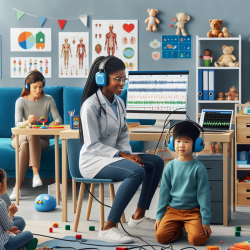Advancements in pediatric audiology have led to the integration of physiological measures to complement traditional behavioral testing, particularly for "difficult to test" populations. The research conducted by Carol Connelly and Dana L. Oviatt provides valuable insights into the application of brainstem and impedance audiometry as objective techniques to assess auditory sensitivity. This blog aims to guide practitioners in enhancing their audiological assessment practices by incorporating these findings and encourages further exploration into the benefits of physiological measures.
Physiological measures, such as auditory brainstem response (ABR) and tympanometry with acoustic reflex testing, offer a reliable alternative to behavioral audiometry when testing young or uncooperative children. These methods provide critical information that might not be accessible through conventional testing, thereby ensuring early and accurate identification of hearing impairments.
Understanding the Techniques:
- Auditory Brainstem Response (ABR): ABR testing uses unfiltered clicks and tone pips to elicit responses, allowing for a closer approximation of the audiogram. This technique is independent of the patient's state of arousal, attention, or cooperation, making it especially useful for infants and young children.
- Tympanometry and Acoustic Reflex Testing: These impedance measures estimate hearing sensitivity and suggest the site of lesion. They further evaluate the function of the middle ear, providing valuable information for the selection of suitable amplification or referral for medical treatment.
Case Studies Highlighting the Impact:
The research paper presents three case studies that illustrate how physiological measures are incorporated into a comprehensive test battery, enhancing the audiological assessment process. These cases demonstrate the effectiveness of ABR and tympanometry in identifying hearing levels, verifying behavioral audiometry results, and guiding the habilitation process. For instance, one case involved a young child with psychomotor delays, where traditional behavioral testing could not yield reliable thresholds. However, through ABR and acoustic reflex thresholds, clinicians were able to suggest normal hearing acuity, underscoring the importance of objective measures in complex cases.
Implications for Practice:
Implementing physiological measures in pediatric audiology practices offers several benefits:
- Ensures early identification and habilitation of hearing impairments, particularly in populations that are difficult to test behaviorally.
- Provides a more accurate audiological profile, essential for selecting appropriate amplification devices.
- Facilitates the verification of behavioral audiometry findings, thereby enhancing the overall reliability of the assessment.
- Accelerates the habilitation process by reducing the need for repeated behavioral testing.
While these objective measures are invaluable, it is crucial to recognize that they do not replace traditional behavioral approaches but rather complement them. A comprehensive audiological assessment should incorporate both physiological and behavioral techniques to fully understand a child's auditory capabilities.
For practitioners looking to improve their skills and expand their knowledge in pediatric audiology, incorporating physiological measures into their practice can lead to more accurate diagnoses and effective treatment plans. Engaging in further research and continuing education on this topic is highly encouraged.
To read the original research paper, please follow this link: Physiologic Measures in Pediatric Audiology.










